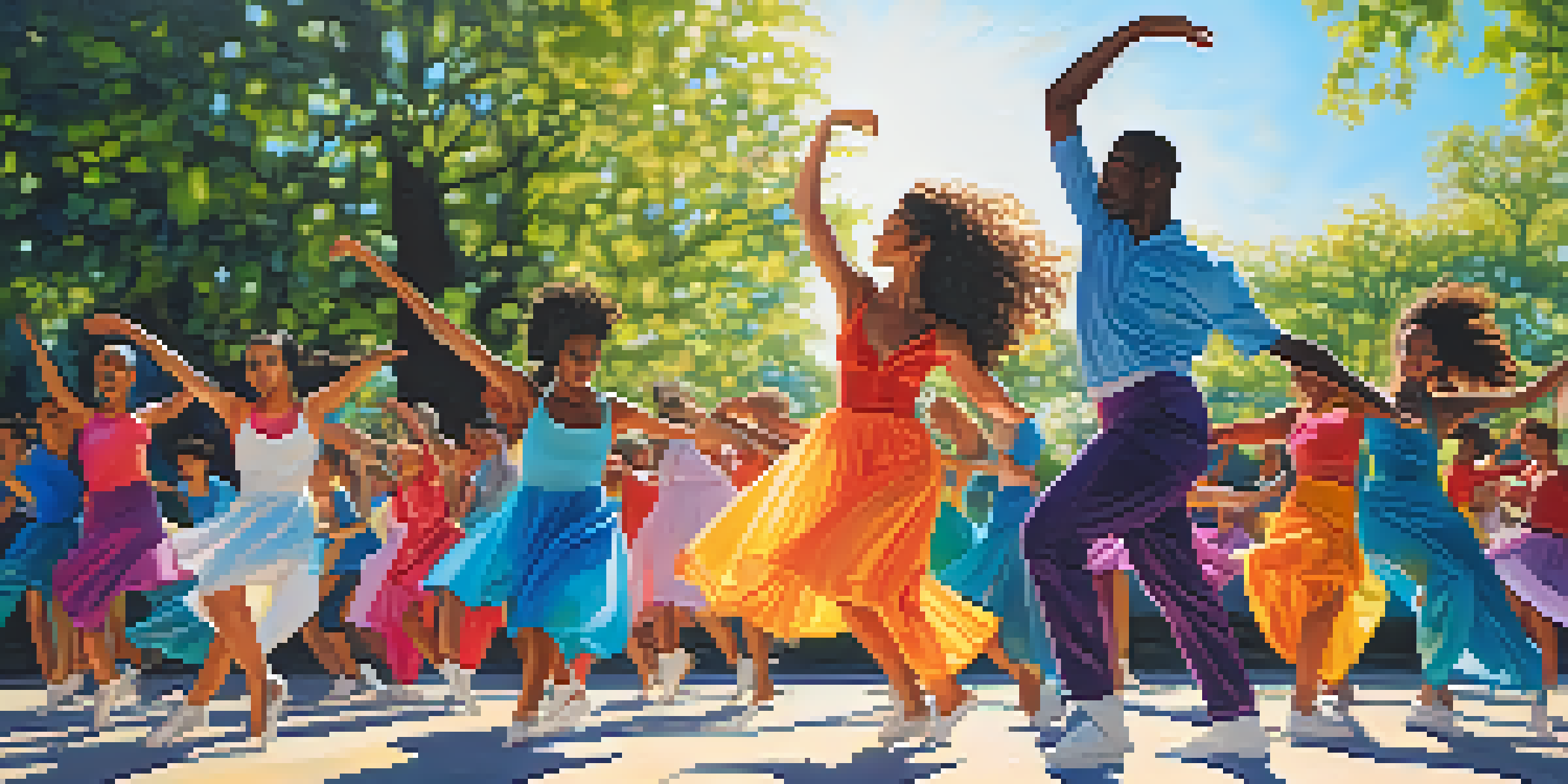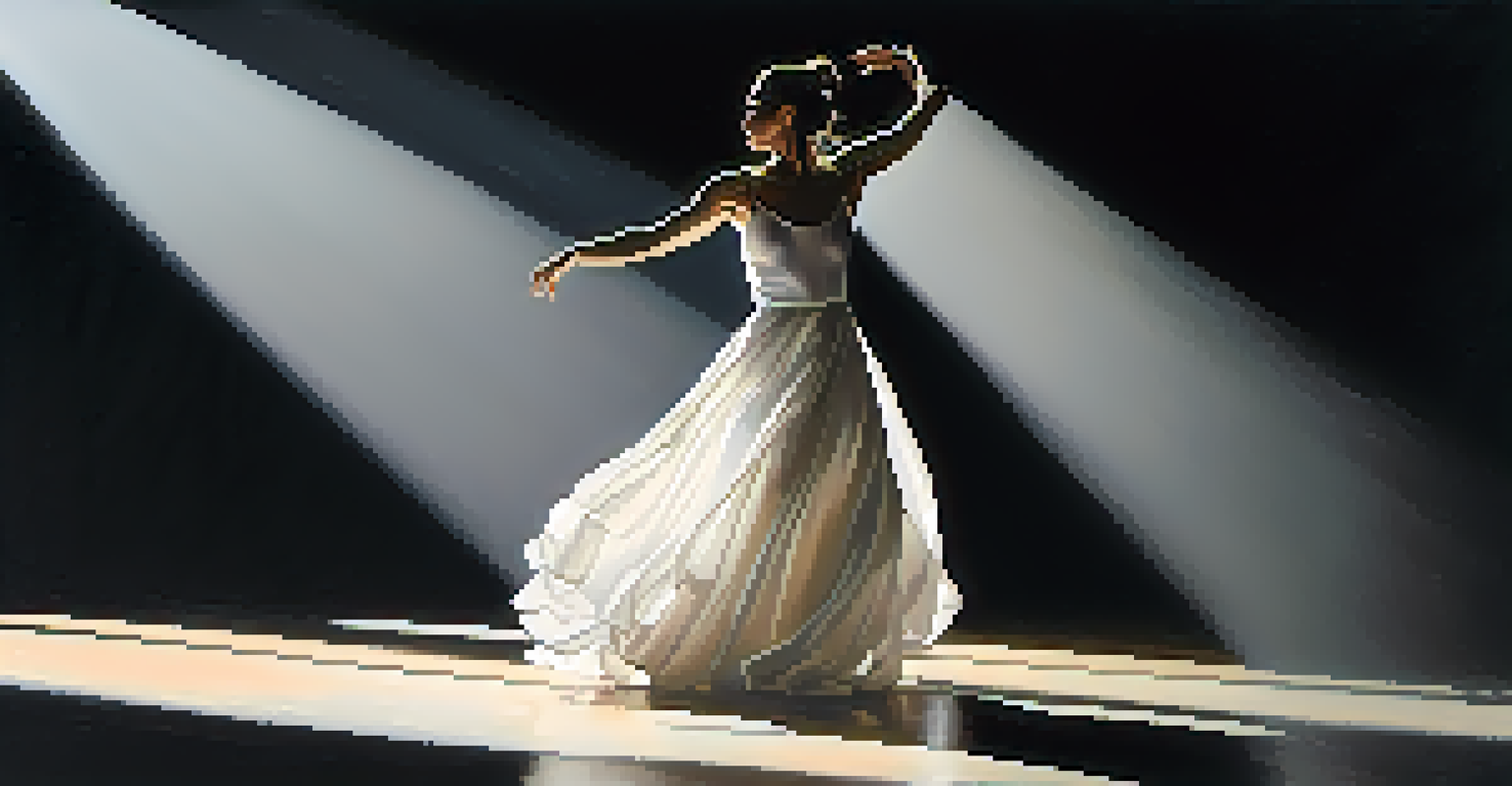Choreography as a Narrative Tool in Digital Platforms

Understanding Choreography's Role in Storytelling
Choreography isn't just about dance; it's a powerful narrative tool. In digital platforms, movement can convey emotions, themes, and character arcs more vividly than words alone. Think of a character's journey depicted through their physical movements, which can express joy, struggle, or transformation.
Dance is the hidden language of the soul.
By integrating choreography into storytelling, creators can engage audiences on a deeper level. For instance, a scene where a character dances alone can signify loneliness or freedom, depending on the context. This visual language acts as a bridge between the story and the viewer's emotions, making the narrative more relatable.
Moreover, choreography provides a unique opportunity for creativity in digital narratives. It encourages artists to explore how movement can enhance plot development or character relationships, making stories not just seen but felt. This synergy between choreography and narrative opens up new avenues for engaging content.
The Rise of Dance and Movement in Digital Media
In recent years, platforms like TikTok and Instagram have popularized dance as a form of expression. These platforms have transformed short choreographed sequences into viral sensations, allowing users to tell stories within seconds. This trend highlights how choreography can captivate audiences and convey complex emotions quickly.

As these digital spaces evolve, they offer a dynamic canvas for storytelling. For example, a simple dance challenge can encapsulate themes of community, resilience, or even humor, resonating with viewers across the globe. Through movement, users can share experiences that transcend language barriers.
Choreography Enhances Storytelling
Integrating choreography into narratives allows creators to convey emotions and themes more vividly than words alone.
Furthermore, the accessibility of these platforms empowers diverse voices to tell their stories through choreography. From professional dancers to everyday users, everyone can contribute to a rich tapestry of narratives, showcasing the universal language of movement. This shift democratizes storytelling, making it more inclusive and varied.
Choreography in Video Games: Engaging Players Narratively
Video games are another arena where choreography plays a crucial role in storytelling. Characters' movements, animations, and interactions can enhance the narrative experience. For instance, a character's agile movements during a chase sequence can heighten tension and immersion, making players feel part of the action.
Choreography is the art of using movement to tell a story.
Games like 'Journey' or 'Celeste' utilize movement not just for gameplay mechanics but as a core part of the narrative. As players navigate through challenges, the choreography of their characters reflects their emotional state and the story's themes. This correlation between movement and narrative creates a memorable experience.
Moreover, choreographed sequences in games often illustrate character development. As players progress, they witness their character's growing confidence or skill through increasingly complex movements. This evolution reinforces the narrative arc, making the gameplay experience more impactful.
Film and Television: Choreography as Visual Storytelling
In film and television, choreography often serves as a storytelling device that goes beyond mere entertainment. Iconic dance scenes, like those in 'West Side Story' or 'La La Land,' encapsulate the characters' emotions and relationships. These choreographed moments transform the narrative, making it more engaging and memorable.
Directors and choreographers collaborate closely to ensure that movement aligns with the story's emotional beats. A well-executed dance can convey a character's internal struggle or connection with others, enriching the storyline. This integration of choreography allows for a multi-dimensional approach to storytelling.
Digital Platforms Foster Collective Dance
Social media challenges create a unique form of community storytelling where users express shared experiences through choreography.
Moreover, choreography can serve as a metaphor within a narrative. For instance, a chaotic dance sequence might symbolize a character's turmoil or confusion. By embedding such layers of meaning within movement, filmmakers can create a deeper connection with the audience, enhancing the overall impact of the story.
Social Media Challenges: Choreography as Community Narratives
Social media challenges often revolve around choreography, creating a unique form of collective storytelling. When users participate in dance challenges, they contribute to a shared narrative that evolves with each new rendition. This communal aspect fosters connections and allows individuals to express their interpretations of a theme.
For example, the 'Renegade' dance challenge on TikTok became a cultural phenomenon, uniting users across demographics in a shared experience. Each participant added their flair while conveying a sense of belonging to a larger story. This illustrates how choreography can build community narratives in the digital age.
Additionally, these challenges can highlight social issues or movements, using choreography as a tool for advocacy. By incorporating meaningful messages into their dances, users can raise awareness and provoke discussions, proving that movement can be a powerful medium for change.
The Impact of Technology on Choreography in Digital Storytelling
Technology plays a pivotal role in shaping how choreography is created and shared in digital storytelling. With tools like motion capture and animation software, choreographers can design intricate movements that enhance the narrative. This technological integration allows for innovative storytelling techniques that were once impossible.
Moreover, augmented reality (AR) and virtual reality (VR) are pushing the boundaries of how audiences experience choreography. For instance, VR experiences allow viewers to immerse themselves in a choreographed performance, feeling as if they are part of the story. This level of engagement transforms traditional storytelling into an interactive experience.
Technology Expands Choreographic Limits
Advancements in technology, such as AR and VR, enhance how choreography is created and experienced in digital storytelling.
As technology continues to advance, the potential for choreography in digital narratives grows exponentially. Creators can experiment with new forms of expression, using movement to tell stories in ways that resonate with audiences on a personal level. This evolution keeps the art of storytelling fresh and exciting.
Challenges and Considerations in Using Choreography Narratively
While choreography offers exciting opportunities for storytelling, it also presents challenges. One major consideration is ensuring that the movement aligns with the narrative's tone and message. Mismatched choreography can disrupt the flow of the story or confuse the audience, diminishing the intended impact.
Furthermore, accessibility is a critical factor. Not all audiences may understand or appreciate choreography in the same way, leading to potential misinterpretations. Creators must be mindful of diverse perspectives and ensure that their use of movement is inclusive and relatable.

Lastly, the evolving nature of digital platforms means that creators must continuously adapt their choreography to keep up with trends. Staying relevant while maintaining authenticity can be a delicate balance, but it’s essential for effective storytelling. By addressing these challenges, artists can harness the full potential of choreography in their narratives.